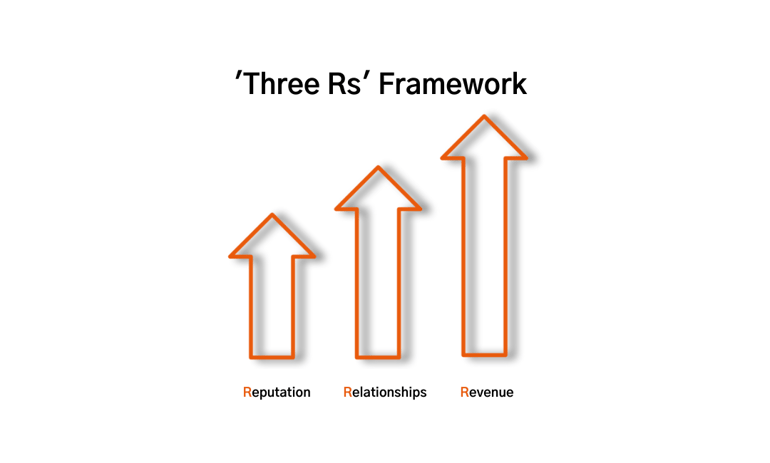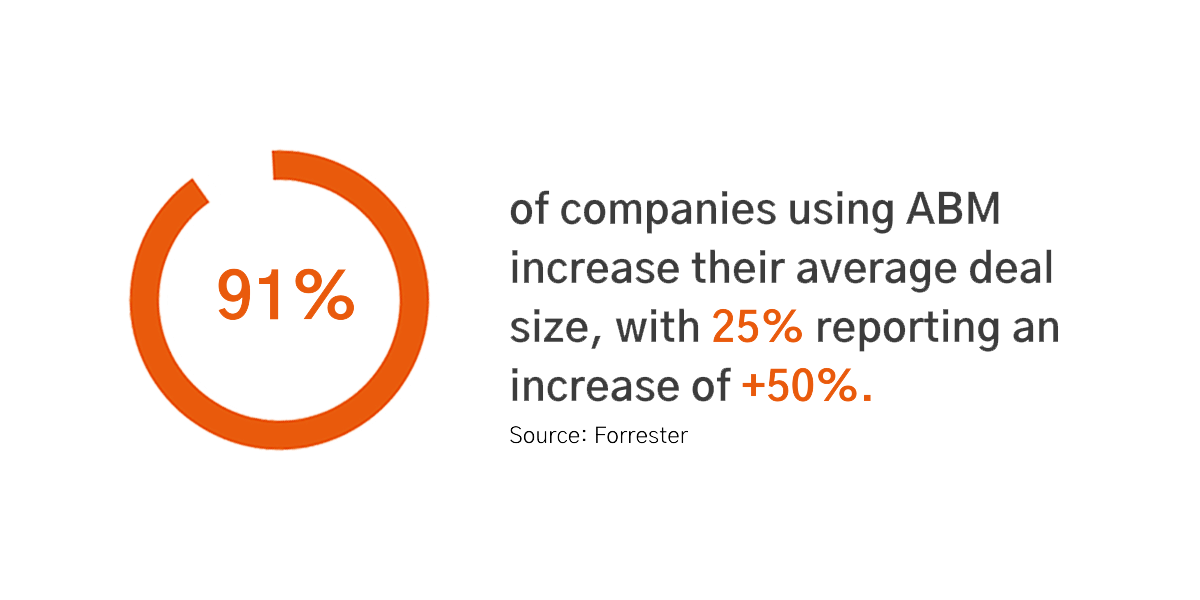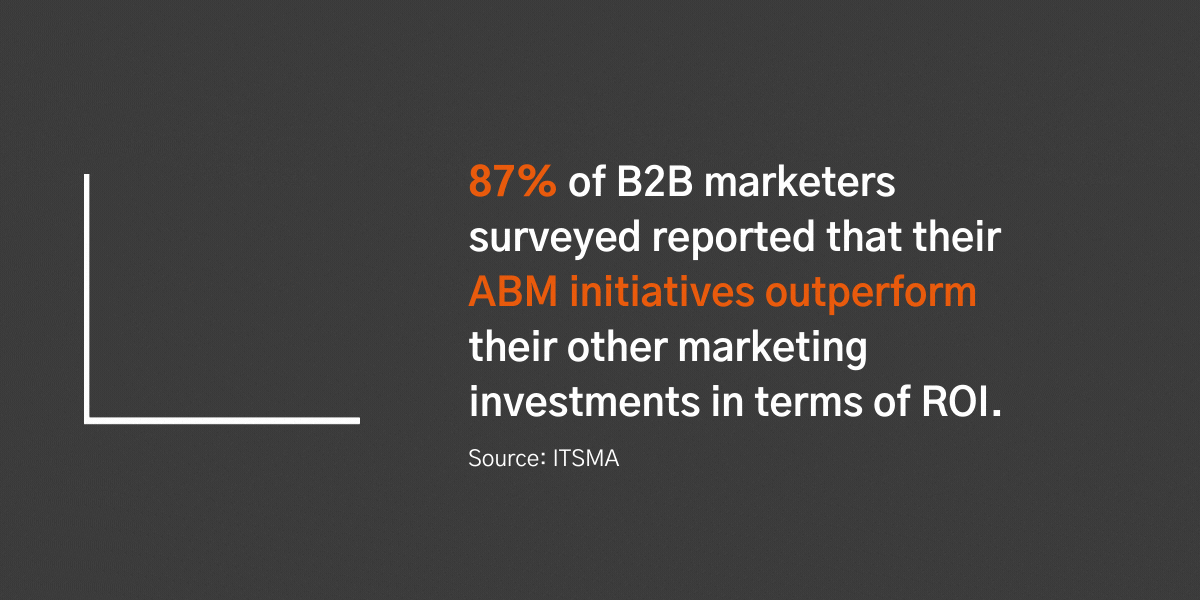We often refer to ABM as a marathon and not a sprint. But while a marathon is measured by crossing the winning line after 26.2 gruelling miles (42.19 km), the success of your ABM strategy can be measured much earlier.
With ABM adoption rates at a record high (61% of companies surveyed in 2020 now have either a full/pilot ABM program), it’s a good time to look at what you should be measuring to know if your ABM strategy is on track.
In this article we’ll explore:
- Why ABM metrics differ from ‘traditional’ Marketing metrics
- The challenge of measuring ABM success
- Why tracking and measuring progress is so important for ABM
- The 3 metrics we believe you should measure - the ‘three Rs’
- How each one of the ‘three Rs’ can be measured in more detail
ABM - The clue is in the name
So what’s different about ABM compared to more ‘traditional’ B2B marketing strategies and how does this impact how it is measured?
Marketing in recent years has seen many companies get ‘high’ on leads - our friends at HubSpot and others changed the Marketing landscape with their inbound methodology that led to a huge increase in Marketing and Sales activity.
But this ‘high’ has been an illusion. Companies have built entire machines around generating hundreds (hell... thousands) of leads.
And Sales apparatus that can deal with them and attempt to close them - “Hey, thanks for downloading our eBook. Would you like a demo?” = hmm...No!
They’ve equally built metrics and Marketing dashboards to justify all this activity - MQLs, SQLs, etc.
.png?width=1200&name=Quote%20image%20-%20Alex%20Olley%20(1).png)
Unfortunately, the numbers do not stack up. The conversion rates are abysmal and the true cost of this machine is staggering.
So, that is where ABM comes in.
ABM is all about the ‘A’ of Account-based Marketing - Accounts.
ABM is a focused strategy to win, grow, and retain your most important Accounts.
You choose which Accounts you want.
You choose what you want to achieve from each Account.
And that’s where the metrics should focus. Measuring the engagement of the Accounts that you are targeting as part of your ABM strategy.
ABM is 100% not about quantity - it’s 100% about quality.
Why is ABM a challenge to measure?
We hear this very often. Why is ABM such a challenge to measure?
There are many ways that I could answer that question.
Ultimately, I think it comes down to the nature of Account-based Marketing - it’s an orchestrated strategy with many moving parts, many actors, many roles and this adds a level of complexity that can often seem daunting.
Here are some of the reasons we often hear that ABM is a challenge to measure:
- How do I measure Account engagement?
- How do I align ABM metrics with my overall marketing objectives?
- What do I measure and at what stage?
- How do I measure the performance of each ABM program type (One-to-many, etc.)?
- How do I show that the ABM program is on track to deliver?
- My Marketing team don’t know how to track everything going on
- How do I pull data from all the different MarTech we use?
This can all sound very depressing. And might put some people off starting their ABM journey.
Our advice? Don't let it. The key thing with ABM is that it is a journey.
You don’t have to get everything right from the beginning. You’ll have time as your ABM program matures and the ability of your team improves. That’s the good news.
The 3 metrics of ABM success
As we mentioned earlier, ABM is a marathon. But the good news is that you can measure the successes throughout this journey and not just at the finish line.
.png?width=1200&name=Quote%20image%20-%20Mathew%20Kent%20(1).png)
Putting in place a robust ABM measurement dashboard allows you to refine your strategy, tweak your tactics and, most importantly, learn.
So what should you measure?
Here at the Agency, we have three metrics.
Only three? The simple answer is yes. The performance of all our ABM programs is measured against the ‘Three Rs’ framework of:
- Reputation
- Relationships
- Revenue
This framework, originally developed by ITSMA, is the bedrock of all our ABM programs.

It is a tried and tested methodology for measuring the impact of your ABM program. It’s a dynamic tool that uncovers insights of the Accounts you are targeting and, most importantly, it aligns your ABM program with the strategic objectives of your C-suite and your overall company strategy to:
- Position your organization as the leader/innovator/etc. in its sector
- Build deep and long-lasting relationships with the accounts that matter most to you
- Maximize (and accelerate) revenue opportunities
So let’s take a look at each element of the ‘Three Rs’ starting with Reputation and how we break down each of these three metrics.
Reputation
Now, this is an interesting one.
When we think Reputation we often think Brand, and when we think Brand we often think Reputation. Mixing these two terms is very common.
They are different and do occupy different spaces and have different roles. Here are a couple of quick definitions to help us advance the conversation:
Brand
A brand generates desire and differentiation and motivates buyers to pay more for your products/services than they might otherwise. A brand is customer-centric, i.e. it is all about relevancy and differentiation.
Reputation
Your reputation is the sum total of your track record in your industry/sector. You build and protect reputation to preserve credibility and trust. A reputation is company-centric, i.e. it is about legitimacy.
These two definitions are very useful when we are thinking of the metric ‘Reputation’ in the context of ABM.
Now the key thing to remember with ABM and Reputation is that we need to be very targeted. Remember that ABM is a strategy focused on a set number of target Accounts.
ABM’s job is not to reposition/enhance, etc. the brand in the eyes of the market, but in the eyes of the target Accounts and the key people within those accounts.
That’s the most important thing to bear in mind.
The Marketing/Brand team will be doing their job with the wider market.
ABM (and ABMers’) job is to focus on the named Account list and build, let’s call them, ‘Reputation-building’ programs.
And all this can be measured.

1. Let's ask them
Classic Marketing but it works. Carry out targeted surveys, interviews, advocacy programs, NPS questionnaires, etc. with the key stakeholders.
- How do they perceive you (now vs. before)?
- Is your new value proposition resonating with them?
- Do they see you as being different from competitors X, Y, and Z?
- Are they providing references to other parts of their businesses?
- Are they becoming advocates to help support your enhanced reputation?
Get this data to the Sales teams working on your ABM accounts. This information is priceless and will help to focus conversations and accelerate deals.
There are also some other things that you should look to measure in addition to the more strategic insights that surveys and conversations with these key stakeholders can deliver.
Let’s take a look.
2. Social media engagement
Social media is a very tangible (and immediate) way to assess your brand performance and reputation. Be it LinkedIn, Twitter, Instagram, or any other platform relevant to your audience, you track:
- Which companies (and individuals) are engaging with your content?
- What are they saying about you?
- Are you building or losing followers?
- Are they sharing your content with their own followers? (this is a great indicator)
- What percentage of your website traffic is from social?
There are a number of great tools out there such as HubSpot, Sprinklr, Meltwater, etc.
3. Campaign engagement
This is perhaps a more quantifiable metric for tracking engagement.
- How many contacts within your named Accounts are opening your emails?
- How many of these contacts are clicking on the content?
- How many of these contacts are accessing additional content on your website?
- How many of these are sharing your content?
- Etc.
.png?width=1200&name=Quote%20image%20-%20Fiona%20Challen%20(1).png)
This is also applicable to your paid campaigns.
- How many people within the Target Accounts view your ads?
- How many click on them?
- What happens next?
4. New webpage visits
Between landing pages, hero assets, gated/ungated content, blogs, etc., you should be attracting your Target Audience to your online environment.
It’s important to measure this engagement and feed this information back to your Sales team in real-time.
Here at the Agency, we use a number of tools to track the engagement of our named Accounts and have alerts set up to feed this information live to our Sales team to inform their outbound strategy.
Relationships
Every Salesperson knows the importance of building strong relationships. It’s what Sales is all about.
Equally, the C-suite spends significant time working very closely with C-suite counterparts in their clients and target accounts. Conversely, Marketing, to date at least, has not been focused on relationships. (More to follow...)
Remember that ABM is a strategic pivot. An organization-wide strategy to win, grow and retain your most important accounts.
And at the center of this are the relationships you make, develop and nurture.
.png?width=1200&name=Quote%20image%20-%20Declan%20Mulkeen%20(1).png)
When you are selling high-value products and services (that have a long and complex sales cycle), the relationships you form with the key client/prospect stakeholders will often make or break these deals.
So how do you measure the impact of your ABM program on Relationships?
- How many contacts do you have inside each Target Account?
- Of these, how many are the ‘right’ contacts inside the Target Account?
- Can any of these contacts be identified as ‘Champions’?
- Can any of these contacts be identified as ‘Blockers’?
- Are you having ‘serious’ conversations with these stakeholders?
- How many sales conversations are you generating?
- How many are accepting invitations to events?
- How many join peer groups, workshops, etc. you organize?
- How many are reading and sharing the content you have created for that account?
I believe that ABM is the greatest unifier of Sales and Marketing, and nowhere more than in the key metric of Relationships is this more visible.
ABM drives Sales and Marketing to work in tandem on creating programs that truly move the dial and create (and develop) those important relationships inside your Target Accounts.
It is these relationships after all that build trust and make your organization the ‘go-to-vendor’.

Revenue
Show me the money...
There is absolute agreement from all the ABM thought leaders I have interviewed on my Let’s talk ABM podcast that ABM is ultimately all about the revenue.
As I mentioned earlier, ABM is a marathon, not a sprint.
The reputation and relationships you develop are the early indicators during that marathon that your ABM strategy is heading in the right direction and will convert into revenue.
But measuring ABM contribution is not a simple matter.
As ABM is invariably focused on long (and complex) sales cycles where there are invariably multiple members of your organization involved - SDRs, AEs, Account Managers, Directors, Marketers, ABMers, etc, that means that it is not always a simple job to calculate the exact contribution that the ABM program had on winning or growing that Account.
But do you need to? If your ABM dollars and resources are focused on a named group of accounts and these accounts grow, are retained, or are won - then that is sufficient, right?
Amber Bogie, a recent Let’s talk ABM podcast guest, equally believes that ABM is a true team sport and, as such, the entire Account engagement activity is contributing to success.
So while we are all in agreement with this position, we are also modern Marketers who understand and speak the language of Sales and Finance.
We are able to stand in a Board meeting and present the impact of our ABM strategy in hard, cold numbers that are irrefutable.
.png?width=1200&name=Quote%20image%20-%20Amber%20Bogie%20(1).png)
So, let’s look at some numbers to help us to hone in on the Revenue metrics we should be looking to track.
- 87% of B2B marketers surveyed reported that their ABM initiatives outperform their other marketing investments in terms of ROI.
- 91% of ABM programs see an increase in average deal size, with 25% increasing more than 50%.
- 86% of marketers report improved win rates with ABM.
- 70% increase in the number of opportunities created via ABM .
- 28% increase in sale/deal velocity.
These numbers shine a light on just some of the Revenue metrics we recommend you measure in your ABM program. Ultimately, each organization is different and some numbers will be more relevant than others.
Our advice? Work with your VP of Sales and build a joint ABM dashboard and report on these numbers together.
Remember ABM is the greatest unifier of Sales and Marketing and success is highly addictive.
1. Meetings booked
ABM is a zero-waste Marketing strategy. If you are focused on the right accounts, then whatever your objective is - meetings booked, workshops attended, demo requests, etc. it will have a financial value. When you combine this with the second revenue metric (win rate) you now have a predictable revenue model.
2. Win rate
ABM drives higher win rates. Why? Because you are targeting the Accounts you want to win, in industries you know, with a value proposition and offering that resonates. You are not trying to please (and sell to) everyone.
Here at the Agency, our win rate is 25%. One in four companies we present to become customers. The actual win rate is significantly higher when you factor out those companies that choose to delay ABM projects.

3. % Pipeline
ABM is all about named Accounts, right?
So track what percentage of your total sales pipeline is coming from these named Accounts. Then track it over time - is it going up or down (it should be going up).
4. Sales/Deal velocity
You have a singular focus on named accounts. You have built unique account experiences that resonate with the account.
Your value proposition is aligned with the challenges and issues faced by your prospects. You are working in tandem with Sales throughout the Sales cycle.
What does this translate into? You close deals faster (28% faster according to a survey by Gartner).
This is probably the least talked about Revenue metric but the one that will set you apart from other Marketers.
5. Annual Contract Value (ACV)
We’re seeing significantly higher ACVs - both with the clients, we win as an Agency, as well as with the campaigns we are running for our clients.
Why? Because you have a singular focus on your ICP.
You know your ICP needs solutions that you can offer. Your ICP recognizes the value exchange in terms of solution and price. This means less discounting, more longer-term deals, and more deals closed at full price.
6. Customer Acquisition Cost (CAC)
How much is it costing to win each client? And are they the right ones?
If you only target those clients you want (i.e. your ICP) then you will significantly reduce wasted Marketing dollars.
Remember that ABM is all about Accounts and not leads. As you get better and better at defining (and redefining) your ICP and Account Selection you will see your CAC reduce.
Track ABM CAC versus other Marketing activities - you’ll be surprised.
Thanks for making it to this point - here's the good news
We hope we’ve given you food for thought on how to measure the impact of your ABM strategy.
Remember, try not to build a comprehensive reporting dashboard on day one. Focus on what is achievable in terms of measuring and build out your full dashboard over time.
Remember: We're here if you want to talk ABM - let's road test your ABM strategy with our ABM Lunch & Learn workshops.









